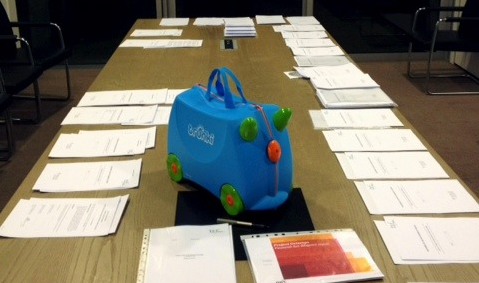The Court of Appeal has overturned the High Court judgment which stated that PMS International’s Kiddee Cases infringed the Trunki, the ride-on suitcase for children renowned for its success after failing to secure funding in the BBC’s Dragons Den.
Viewed as a British design success story, this is likely to be a controversial decision and Magmatic, which owns the design rights in the Trunki, is clearly disappointed. Indeed, the company has already announced its intention to appeal.
A registered design may protect the appearance of the whole or a part of a product resulting from its lines, contours, colour, shape, texture or ornamentation. Under current design law that applies in the UK and many European countries, and also to community registered design (CRD) applications (which are valid throughout the whole EU), there is a broad definition of what is registrable as a design.
It is possible to protect a 3D visual appearance, such as the shape of a new product. The registered design may be concerned with the whole of the product, or just part of it. To be registrable, the design must be new, and must also have ‘individual character’, a subjective test meaning that the design must produce a different overall impression on the ‘informed user’ compared with any previous designs. When assessing individual character, the degree of freedom of the designer in developing the design shall be taken into consideration.
The overturning of the High Court decision was based on two main factors. Firstly, the fact that the Trunki CRD was clearly intended to look like a horned animal was not taken into account when comparing the CRD and the Kiddee Cases. The Court of Appeal held that the insect and tiger versions of the Kiddee Case conveyed completely different impressions on the informed user in comparison with the CRD, as they appeared to have antennae and floppy ears respectively, as opposed to horns.
Secondly, and more interestingly, the Court of Appeal disagreed with the High Court’s findings in relation to surface decoration, where it was held that the Kiddee Cases’ surface design should be ignored as there was nothing comparable on the CRD. The Court of Appeal discussed the Samsung v Apple tablet case ([2012] EWCA Civ 1339), in which it was held that the absence of decoration on Apple’s registered design for the iPad was an important feature in itself when comparing the design with the Samsung tablet (which did include surface ornamentation).
Apple’s registered design consisted of simple line drawings, and the lack of decoration on the design contributed to the slick and cool impression it exuded, a point that Apple itself was keen to emphasise.
In the Trunki appeal, the court held that the first instance judge was wrong to eliminate the Kiddee Cases’ surface decoration in its assessment of infringement because it significantly affected the overall impression of the designs and demonstrated that neither of the Kiddee Cases was a symmetrical stylised design of a horned animal, which is what the CRD was intended to represent.
Furthermore, the Court of Appeal found that the colour contrast between the wheels and the body of the CRD was a striking feature and this should have been taken into account when comparing the CRD with the Kiddee Cases. In relation to this point, the Court of Appeal commented how the CRD comprised ‘computer generated three-dimensional images which show the suitcase from different perspectives and angles and show the effect of light upon its surfaces’, as opposed to the simple two dimensional line drawings other designs use. Whilst an exaggeratedly simple design may raise validity issues, it is perhaps worth remembering that the more detailed the design drawings, the clearer the ‘impression’ arguably given by the design.
It will be interesting to monitor the reaction to this decision, from both a legal perspective in any subsequent appeal, but also from the market itself. The decision does not necessarily mean that the simple addition of surface decoration will be enough to differentiate a particular product from a similar product that is protected by a registered design, although this may be a factor that is relevant in the context of an overall comparison.
As ever, much will turn on the specific facts of each case, and it is always seeking professional advice is always recommended when dealing with this complex area of law. With an appeal on the horizon in the Trunki dispute, it is still not clear who will be riding into the sunset just yet.
See also: Dragons’ Den reject Trunki packs up investment from Business Growth Fund






